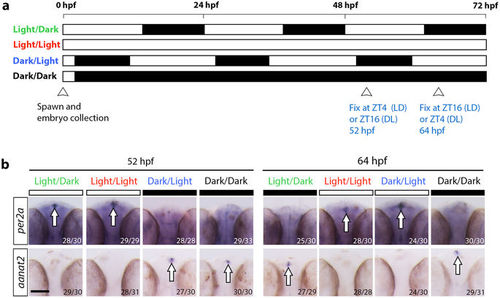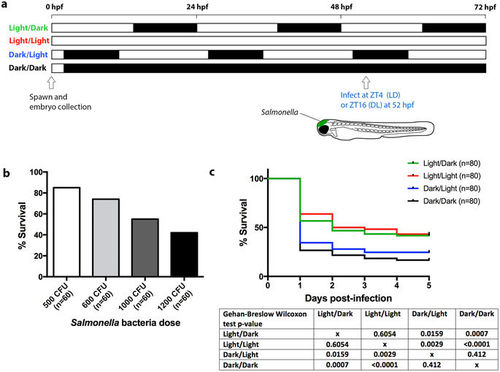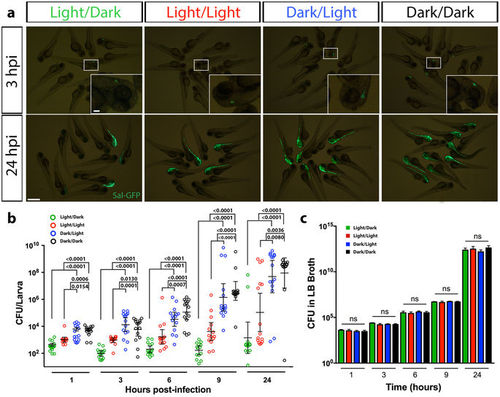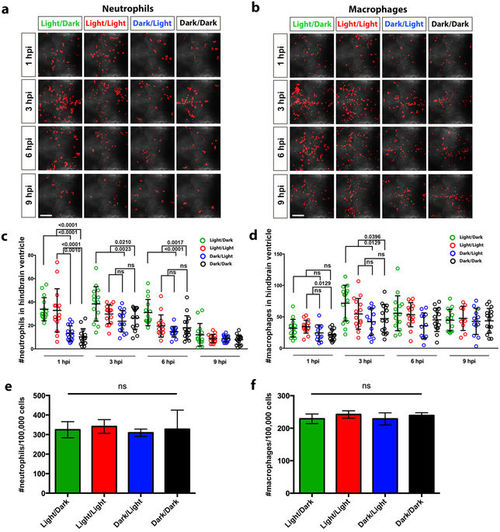- Title
-
The innate immune cell response to bacterial infection in larval zebrafish is light-regulated
- Authors
- Du, L.Y., Darroch, H., Keerthisinghe, P., Ashimbayeva, E., Astin, J.W., Crosier, K.E., Crosier, P.S., Warman, G., Cheeseman, J., Hall, C.J.
- Source
- Full text @ Sci. Rep.
|
Validation of light-induced rhythmicity by assessing expression of the clock output genes, per2a and aanat2, under different light conditions. (a) Schematic outlining the light conditions and subsequent experimental manipulations. (b) Expression analysis of per2a and aanat2 at 52 hpf and 64 hpf, as detected by whole mount in situ hybridization (WMISH) for larvae raised under the different light conditions, as shown in (a). ZT, zeitgeber time where ZT0 represents start of the light phase; bars above WMISH images denote the light setting at the time of fixation, white bar = light, black bar = dark; numbers represent number of larvae with displayed phenotype; hpf, hours post-fertilization; arrowheads indicate the time of expression analysis; scale bar, 100 μm; arrows mark per2a or aanat2 expression in the pineal gland. |
|
The survival of zebrafish larvae infected with Salmonella is higher under light exposure. (a) Schematic outlining the light conditions and timing of infection. (b) Survival outcome (% survival) of larvae infected with different doses of Salmonella under light/dark conditions. (c) Kaplan-Meier survival graph showing the % survival of infected larvae from the light/dark, constant light, dark/light and constant darkness groups from 1 to 5 days post-infection. ZT, zeitgeber time where ZT0 represents start of the light phase; hpf, hours post-fertilization. |
|
Larvae infected with Salmonella during light exposure demonstrate enhanced bacterial clearance. (a) Live imaging of larvae infected with GFP-labeled Salmonella, at 3 and 24 hpi under light/dark, constant light, dark/light and constant dark conditions. Inset, magnified view of boxed region. (b) CFU counts of GFP-labeled Salmonella within individual infected larvae raised under light/dark, constant light, dark/light and constant dark conditions. (c) CFU measurements of GFP-labeled Salmonella in Luria Bertani broth grown under light/dark, constant light, dark/light and constant dark conditions over a 24- hour period. Scale bar, 500 μm and 100 μm in inset; hpi, hours post-infection; data in (c) represent three biological replicates; data shown as mean ± s.e.m. in (b) and s.d. in (c); p-values were calculated by one-way ANOVA with Tukey’s multiple comparisons test; ns, not significant. |
|
Larvae infected under light exposure demonstrate greater recruitment of neutrophils and macrophages to the hindbrain ventricle. (a) Immunofluorescence detection of neutrophils at 1, 3, 6 and 9 hpi within the hindbrain region of infected Tg(lyz:DsRED2) nz50 larvae raised under light/dark, constant light, dark/light and constant dark conditions. (b) Immunofluorescence detection of macrophages at 1, 3, 6 and 9 hpi within the hindbrain region of infected Tg(mpeg1:Gal4-FF) gl25 ;Tg(UAS-E1b:nfsB.mCherry) c264 larvae raised under light/dark, constant light, dark/light and constant dark conditions. (c) Quantification of neutrophils in the hindbrain region of individual infected Tg(lyz:DsRED2) nz50 larvae, as detected in (a). (d) Quantification of macrophages in the hindbrain region of individual Tg(mpeg1:Gal4-FF) gl25 ;Tg(UAS-E1b:nfsB.mCherry) c264 larvae, as detected in (b). (e,f) Flow cytometry quantification of neutrophils and macrophages from Tg(lyz:DsRED2) nz50 and Tg(mpeg1:Gal4-FF) gl25;Tg(UAS-E1b:nfsB.mCherry) c264 larvae, respectively, raised under light/dark, constant light, dark/light and constant dark conditions. Data represent three biological replicates. Scale bar, 50 μm; data shown as mean ± s.d.; hpi, hours post-infection; p-values were calculated by one-way ANOVA with Tukey’s multiple comparisons test; ns, not significant. |
|
Summary of the innate immune response to bacterial infection in larval zebrafish under different light conditions. The innate immune response can be divided into two states with enhanced bacterial clearance and survival when infection occurs under light exposure in the light/dark and constant light groups. This is, at least in part, the result of greater pro-inflammatory cytokine expression and neutrophil and macrophage recruitment to the infection site. In contrast, when infected during the dark condition (either under dark/light or constant darkness) there is reduced bacterial clearance and survival that coincides with a reduction in pro-inflammatory gene expression and leukocyte recruitment. |





